Scaling your Growth team—tips from Shopify, GitHub, and Teamwork
To scale Growth, you need to define its purpose, set goals, structure collaboration, and master your customer data. Three experts share their insights.
To scale Growth, you need to define its purpose, set goals, structure collaboration, and master your customer data. Three experts share their insights.
Many startup founders, executives, and marketers search for the golden formula to managing Growth in their organizations. But ask three growth practitioners how to scale and structure Growth at startups, and you'll get three different answers.
To scale Growth at your company, you need to define its purpose, set goals, structure collaboration, and master your use of customer data. Plus, to win the game of Growth, all these activities need to happen at breathtaking speed.
For an episode of Growth Masters, we discussed how to scale and structure Growth with three leading growth experts:

Growth serves a specific function: maximizing the value of one or more assets of the business—usually its products. Growth teams achieve this function through a deep understanding of their customers and by running constant experiments and tweaks throughout the customer journey. Thibault says you can apply the force of Growth teams "to customer acquisition, conversion optimization, or any kind of KPI."
Startups often delegate Growth responsibilities too early, set up Growth teams incorrectly, or hire the wrong people when they misunderstand Growth's purpose. Tara says before you even consider who should be on your Growth team, you should ask yourself, "What do we want Growth to solve?" and then define goals that serve your answers to that question.
Early-stage startups with limited resources should pick just one goal for the Growth team to create focus. Often, that goal for early-stage startups will relate to acquisition—getting more users—or engagement—increasing daily or monthly active users. "Those are the type of goals that help them reach product/market fit and raise their next round," says Thibault.
At growing and larger companies, the ultimate goal of Growth teams is usually to increase revenue. At GitHub, for example, they think of Growth as a Sales team, and Thibault reports to the SVP of Revenue.
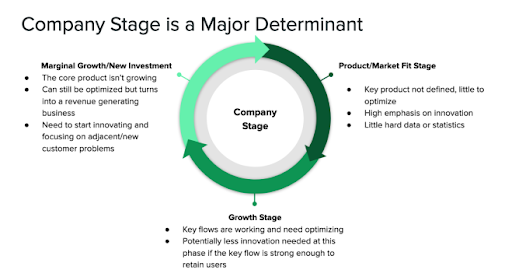
Growth at such organizations usually expands its scope to several stages of the customer journey. Larger companies might even dedicate entire teams to a specific KPI or product feature. Morgan's team at Shopify, for example, is exclusively focused on acquiring more merchants for the eCommerce platform. They do so by pursuing the goal of improving Shopify's self-serve capabilities for sellers.
Growth teams at larger companies might also set infrastructure optimization goals that help them launch and run experiments faster. Casey Winter—former Growth Lead at Pinterest—and his team spent nine months optimizing their email infrastructure to provide personalized, content-based recommendations.
There's increasing overlap between the disciplines of Growth, Product, and Marketing and no ironclad rules on the boundaries between them. You'll have to set those boundaries for your organization to limit confusion and turf wars.
"Org follows strategy and not the other way around." - Thibault Imbert, VP Growth at GitHub
The Growth goals you've set and the stage of your company usually determine where the team should live in your organization:
When your team is in early-stage growth, place Growth under the CEO or leadership team.
If your goal is acquisition, place under Marketing or the Head of Lead Gen.
If your goal is engagement, onboarding, or another product-driven KPI, place under Product.
If your goal is revenue, place under the CFO or Head of Sales.
Morgan recommends placing Growth, Product, and Marketing under one leader as your company grows to avoid finger-pointing when problems arise. (Growth, for example, saying they can't hit their goals because Marketing or Sales brings them the wrong type of users.) You'll also want to establish clear ownership of different assets, like the website, in-app experience, or brand.
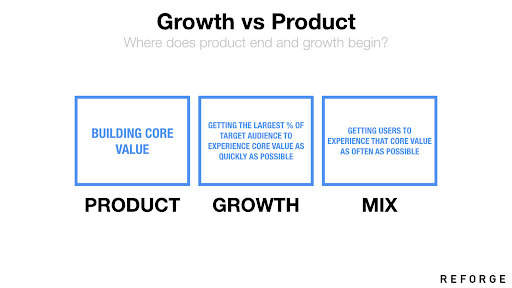
You might even see a split within the Growth department at larger companies, between Growth Marketing and Growth Product. In such cases, everything before and outside of the app experience—like signups, awareness, and email campaigns that support the product—is part of Growth Marketing. The in-app experience—onboarding, trials, subscription flows—falls under Growth Product.
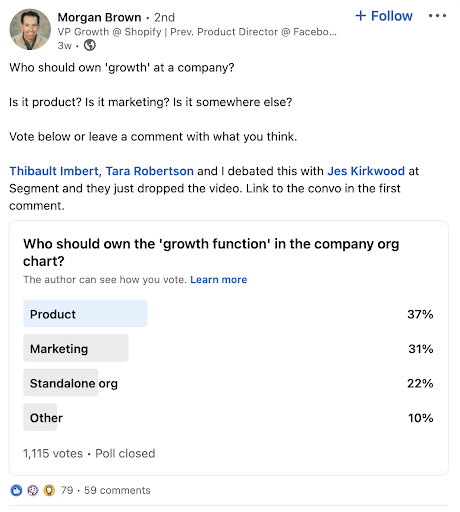
"The best startups grow super fast," notes Casey, "not because of traditional marketing or online marketing, but because they tune the product to drive growth." The product is the primary driver for acquiring, converting, engaging, or upselling customers at such organizations—usually called product-led growth (PLG) businesses. The Growth team then almost naturally merges into the Product department.
"All PMs should be thinking about growth now," says Morgan, previously Product Director at Facebook. There, growth is a product function, separate from Sales and Marketing but embedded in the Product team. This structure means the Product Manager is also responsible for Growth.
Brian Norgard, former Chief Product Officer (CPO) at Tinder turned investor, sums this shift up in a somewhat bold tweet:
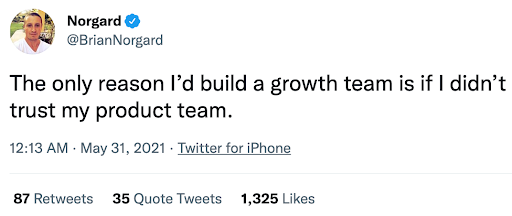
The Growth team's objectives evolve and change—sometimes rapidly—because you can apply their maximization efforts to different aspects of the business. You'll need to create responsibilities and processes that facilitate goal setting and collaboration, both within the Growth team and between Growth and other functions, like Product and Marketing.
“All three functions are driving toward ARR as the highest-level KPI, and from a PLG perspective, all teams should be thinking about reducing friction at every point of the customer journey, from pre-signup to post-signup.” – Kevan Lee, Head of Marketing at Oyster
You'll need to define the different responsibilities of Growth, Marketing, and Product, even though they usually contribute to the same high-level KPI and regardless of where Growth lives in your organization. Kyle Poyar, partner and former VP of Growth at OpenView Partners, uses these definitions:
"Product = Builds something that delivers value and/or solves a specific problem for a specific group of people
Marketing = Attracts an audience that’s interested in experiencing that value provided
Growth = Gets that audience to experience the product value as fast as possible"
The distinction between Growth and Marketing is especially tricky. Marketing traditionally was responsible for acquiring new customers and getting value from existing ones. Now Growth often owns or co-owns these activities in many organizations. But Tara thinks there are still things only Marketing can do best—creative work, PR, and managing the brand, for example. At the same time, not every Marketer can nor should be thinking about growth frameworks and experiments.
Marketing can also play a "supporting role" around the product by owning messaging, content, and channels outside of the app, like email, social, and advertising.
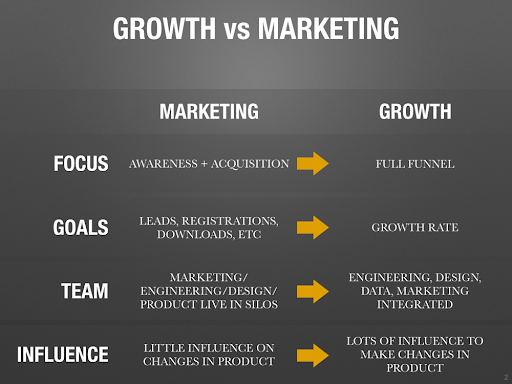
At Teamwork, Tara uses a quarterly planning process to bring all teams together for a shared roadmap session. Business needs and goals inform the roadmap and highlight the most significant opportunities for experiments and value maximization.
She recommends "break[ing] down the overall goal into specific team goals, displayed on dashboards, which teams then review every day to see their progress." Their current high-level quarterly goal, for example, is to increase Product Qualified Leads (PQLs). Such leads are people who have experienced the value of Teamwork's product through their freemium price tier or a free trial. This overarching objective means different teams like Growth, Marketing, and Sales each have sub-goals that help drive stronger PQLs.
Once you've set goals during the roadmap session, representatives from each team—like the Heads of Marketing, Growth, and Product—meet in standup meetings throughout the quarter. During those get-togethers, they share info, explore opportunities, and avoid collisions between different teams.
Another approach—when goals stay the same for a more extended period—is assigning funnel stages and assets to different teams, for example, acquisition on the website to Marketing and onboarding in the product to Growth.
"The future of growth," says Tara, "is about the future of the customer experience and the way you can unlock people getting to value at a much faster rate." You can only generate more value for users at ever-increasing speeds when you have trusted customer information and a passion for data in your company DNA.
"Competition will always be greater tomorrow than it is today." - Morgan Brown, VP Growth Marketing at Shopify
Intense competition ensures that Customer Acquisition Cost (CAC) keeps increasing and even makes traditional inbound marketing and lead generation strategies less effective. Stricter privacy regulations have further reduced the possibility of relying on acquisition based on advertising using third-party data.
Because of these forces, Tara says most SaaS businesses get to a point where they can get more value from their existing customers than from acquiring new ones. But this only works when you deliver value quickly through an exceptional product experience. Otherwise, people head elsewhere as their attention is limited and choice is abundant.
To continuously increase the value your product delivers, you need reliable customer data for insights your teams can act on. With such a process, you ensure the people already using your product are happy and refer other customers.
According to Morgan, the companies that win are those that can run through the following steps as fast as possible:
Collect and process large amounts of customer data.
Turn that information into valuable insights.
Use those insights for strategy and execution that lead to increased customer value.
Some of the world's biggest and fastest-growing companies are doing precisely this. Most people don't understand how fast those organizations are moving, says Thibault. Their advantages gained from their speed compound over time, increasing their lead even further.
Growth keeps evolving rapidly, and its importance in organizations increases every year. To be and stay successful as a Growth leader or team, you need to adjust to change quickly and make sure your teams and processes are ready to scale, too.
You'll also need to prepare for a future where Product, Marketing, and Growth converge to deliver and maximize customer value at an ever-increasing pace. CMOs might become Chief Growth Officers soon. The role of Product Manager having responsibility for Growth seems likely to become the default at most companies.
The appearance of a one-size-fits-all approach for implementing Growth at companies seems unlikely, however. Managing and scaling Growth will always require a custom approach—and constant iteration—depending on your business objectives, the stage and size of your company, and your culture.

Our annual look at how attitudes, preferences, and experiences with personalization have evolved over the past year.